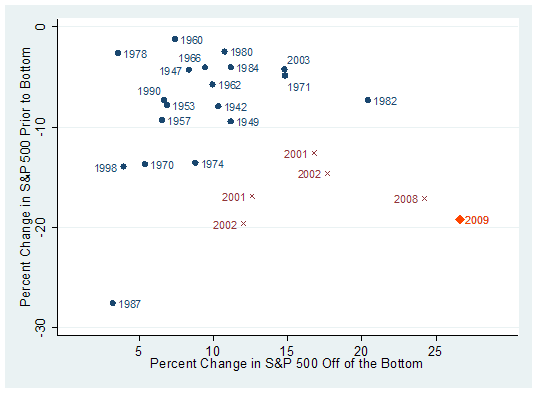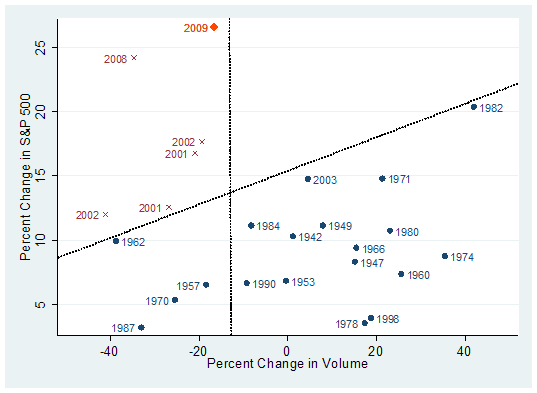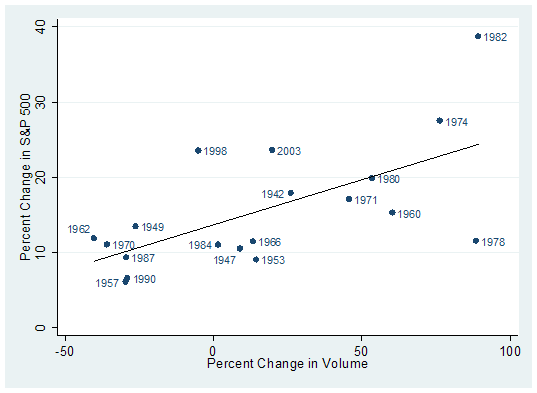Source: Jeff Clark, Casey Research 05/01/2009
Gold isn’t going to $2,000 an ounce.
Before you gag on your coffee or suffer chest pains, allow me to explain.
We’re about eight years into the bull market, and gold has breached the $1,000 level twice and has spent weeks
trading above the old high of $850. Some observers are now saying that gold’s pretty much had its day and that
once the recession is over, it will retreat for good.
However, the four-digit gold price we’ve seen so far is with no price inflation to speak of, no effects of the
atrocious increase in the money supply, and despite a rising dollar. What happens to gold when each of those
pictures gets turned upside down – high inflation, excess cash jolting the economy, and a falling dollar?
After all, gold’s performance to date has been powered only by general anxiety, not by any visible erosion in
the dollar’s value.
I decided to take a fresh look at calculations that could be used to appraise gold’s upside potential. No one
of them, by itself, comes with compelling logic. But they all point in the same direction.
Gold’s Percentage Rise in the Last Bull Market. What if gold in this bull market repeats the percentage rise
in the last bull market? In the 1970s gold rose from $35 to $850, a factor of 24.28. Our low in 2001 was
$255.95. Multiply that by 24.28 and you get a gold price of $6,214 per ounce.
U.S. Gold Holdings to Money Supply: The M1 money supply consists of currency and checkable deposits. The U.S.
government currently holds 286.9 million ounces of gold. If the government were to make each dollar redeemable
by the amount of gold it possesses, we’d arrive at the following price for gold: $1.569 trillion ÷ 286.9
million oz. = $5,468.80 per ounce.
Gold/Dow Ratio: The ratio was about “1” when gold peaked in 1980, meaning the Dow and gold were the same
price. To restore that relationship at today’s stock prices would mean when the Dow is at 6,626, gold should
be at $6,626/oz. Of course, we think it likely that the Dow will get a lot lower before gold peaks. But even
if it drops all the way to 4,000, that would imply a gold price of $4,000/oz.
All the Money in the World vs. Gold Reserves: If the public eventually sees the paper game being run by the
central banks for what it is, governments will be forced to back their currencies with gold (and perhaps other
tangibles like silver). Assuming they had to go into the market and buy the gold needed to restore faith in
their currencies, the numbers might look like this: Total central banks reserves (including gold holdings) =
$4.8 trillion, divided by 929.6 million ounces total gold reserves held by all official institutions that
issue currency = $5,246 gold price.
U.S. Gold Holdings to U.S. Foreign Trade Deficit: The size of a country's deficit or surplus would be of no
consequence if all currencies were convertible into a fixed amount of gold. However, the dollar is
increasingly considered a hot potato, and when the trade balance reverses, as it must, dollars will flow back
to the U.S. and fuel domestic price inflation. Based on the cumulative trade deficit of $9.13 trillion (up
from $6 trillion since June ‘07!) and U.S. gold holdings of 286.9 million ounces, the corresponding price of
gold would be $31,822 per ounce.
U.S. Gold to U.S. Government Liabilities: Finally, the GAO (Government Accountability Office) calculates an
income statement and balance sheet for the U.S. government. As you’d suspect, it is dominated by future
liabilities for Medicare and Social Security. What if they had to be backed by the supply of gold? Official
U.S. government liabilities now ring in at an incredible $55.2 trillion. To make good on that would require a
$192,401 gold price.
No, we don’t think gold will hit $192,000 or even $32,000. And there really isn’t any surefire way to forecast
the eventual high. But it’s clear that every weathervane is pointing in the same direction. So, yes, gold
isn’t going to $2,000; it’s going higher.
Witness the Breakdown
When determining how to keep your wealth safe, the state of global affairs can be a powerful reminder that
gold should be part of the strategy. And today our world, essentially, is on fire.
Eastern Europe borders on bankruptcy. Brazil's economy is falling off a cliff. Ditto Mexico.
Protests have erupted in Latvia, Chile, Greece, Bulgaria, Iceland, Dublin, and parts of the U.S. Workers have
gone on strike in Britain and France.
In the U.S., 36 states and the District of Columbia have proposed or implemented reductions in the civil
workforce. (You think customer service is poor now...)
An astounding one in nine homes, 14 million, sits empty in the U.S. The December median price of a home sold
in Detroit was $7,500. More than 8.3 million homeowners were upside down on their mortgage in the fourth
quarter. Freddie Mac's new CEO resigned after six months on the job.
Last quarter, 12 U.S. banks failed, bringing the 2008 total to 25, the highest one-year death rate since 50
failed in 1993. More foreboding, another 252 banks joined the FDIC’s “problem list.” So far this year, 19
banks have failed.
The central bank of Ukraine banned the early redemption of term deposits, the most popular form of savings in
the country. Bank deposits have dropped 20% since September, as bank customers dodge the risk of getting
locked in.
The projected US$1.75 trillion federal budget deficit is almost four times the nation’s previous record-high
budget deficit. The Times Square debt clock reads over $11 trillion. Japan’s now reads $7.8 trillion.
High unemployment has become a worldwide epidemic, with the infection spreading.
With world economies taking it on the chin, it’s little wonder that investor interest in gold as a safe haven
is growing – a trend we expect to continue. And just wait until the dollar resumes its slide, the expanding
money supply jolts the real economy, and inflation kicks in.
Both Hands on the Wheel
Given the ongoing turmoil and the swallowing darkness at the end of the crumbling economic tunnel, our
recommended BIG GOLD strategy remains keeping one-third in cash, one-third in physical gold, and one-third in
our selected gold stocks. New money for investment should be split among the same three categories; we just
don’t see any safer places to be.
As economies around the world continue to shrink and governments continue administering larger doses of the
wrong medicine, we’ll sit in relative comfort with our gold for protection and our stocks for profit. We
expect the prices of both to rise as others join us.
Even though some of the mainstream media are already popping the champagne, cheerfully pronouncing the end of
the crisis, we beg to differ. The economic quagmire the U.S. and much of the developed world is in is far from
over… so be right and sit tight, as we at Casey Research like to say.









